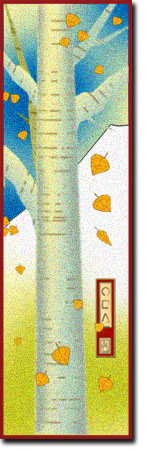On The Way: The Daily Zen Journal
Platform Sutra – Part 1
Hui-neng
I have come here today because I have a connection of many lifetimes with you, officials, clerics, and laypeople. This teaching has been passed down by the ancients. It isn’t something I discovered by myself. But if you wish to hear this teaching of the ancients, you must listen with pure minds. And if you wish to get rid of your delusions, you should understand it as past generations have.
Good friends! You already possess the prajna wisdom of enlightenment!
But because your minds are deluded, you can’t understand by yourselves. You need to find a truly good friend to show you the way to see your nature. Good friends, Buddha nature isn’t different for the ignorant and the wise. It’s just that people are deluded or awake. When people are deluded, they’re ignorant. When they wake up, they become wise.
Good friends, this Dharma teaching of mine is based on meditation and wisdom. But don’t make the mistake of thinking that meditation and wisdom are separate. Meditation and wisdom are of one essence and not two. Meditation is the body of wisdom, and wisdom is the function of meditation. Wherever you find wisdom, you find meditation. And wherever you find meditation, you find wisdom. Good friends, what this means is that meditation and wisdom are the same.
Fellow students of the Way, be careful. Don’t think that meditation comes first and then gives rise to wisdom or that wisdom comes first and then gives rise to meditation or that meditation and wisdom are separate. For those who hold such views, the Dharma is dualistic: If the mouth speaks of goodness, but the mind doesn’t think of goodness, meditation and wisdom are not the same. But if goodness pervades both the mouth and the mind, if what is external and internal are alike, then meditation and wisdom are the same.
The cultivation of self-awareness does not involve argument. People who argue about which comes first and which comes second only confuse themselves. Unless you put an end to right and wrong, you will give rise to self-existent dharmas, and you will never be free of the Four States.

One Practice Samadhi means at all times, whether walking, standing, sitting, or lying down, always practicing with a straightforward mind.
The Vimalakirti Sutra says, “A straightforward mind is the place of enlightenment,” and “a straightforward mind is the pure land.” Don’t practice hypocrisy with your mind, while you talk about a straightforward mind with your mouth.
If you speak about One Practice Samadhi with your mouth, but don’t practice with a straightforward mind, you’re no disciple of the Buddha. Simply practice with a straightforward mind and don’t become attached to any dharma. This is what is meant by One Practice Samadhi.
Deluded people who cling to the external attributes of a dharma get hold of One Practice Samadhi and just say that sitting motionless, eliminating delusions, and not thinking thoughts are One Practice Samadhi. But if that were true, a dharma like that would be the same as lifelessness and would constitute an obstruction of the Way instead.
The Way has to flow freely. Why block it up? The Way flows freely when the mind doesn’t dwell on any dharma. Once it dwells on something, it becomes bound. If sitting motionless were right, Vimalakirti wouldn’t have criticized Shariputra for meditating in the forest.
Good friends, I know there are people who tell others to devote themselves to sitting and contemplating their minds on purity and not to move or think. Deluded people are unaware, so they turn things upside down with their attachments. There are hundreds of such people who teach the Way like this. But they are, you should know, greatly mistaken.
Good friends, what are meditation and wisdom like? They’re like a lamp and its light. When there’s a lamp, there’s light. When there’s no lamp, there’s no light. The lamp is the light’s body, and light is the lamp’s function. They have two names but not two bodies. This teaching concerning meditation and wisdom is also like this.
Hui-neng (638-713)
Sixth Patriarch of Zen
Excerpted from The Platform Sutra – The Zen Teaching of Hui-neng translated by Red Pine 2006





One of the most famous Zen tales is the story of how an illiterate woodcutter came to inherit the robe and bowl of the 5th Patriarch.
After delivering his load of firewood one day, he heard a customer reciting the Diamond Sutra. He felt clear and awake upon hearing this, and asked the man where he learned this sutra. Upon hearing the location, directions, and name of Hung-jen, the Fifth Patriarch, he determined to arrange his family affairs and proceed there to study. The famous story continues from there…Most people don’t get too far past the beginning of the sutra, which is his autobiography, that in itself adds a unique twist to this sutra.
As powerful as this part of the sutra is, the following sections deserve careful study. Many of us get lost in the verbiage of other sutras, the vast descriptions and kalpas of time, the use of repetition, which leads us seeking where the teaching itself begins again. In the Platform Sutra, there seems to be no wasted words. And the line that speaks so clearly to us:
“Good friends, if you wish to practice this, you can do it at home, too. It doesn’t require living in a monastery.”
Yours along the Way,
Elana, Scribe for Daily Zen